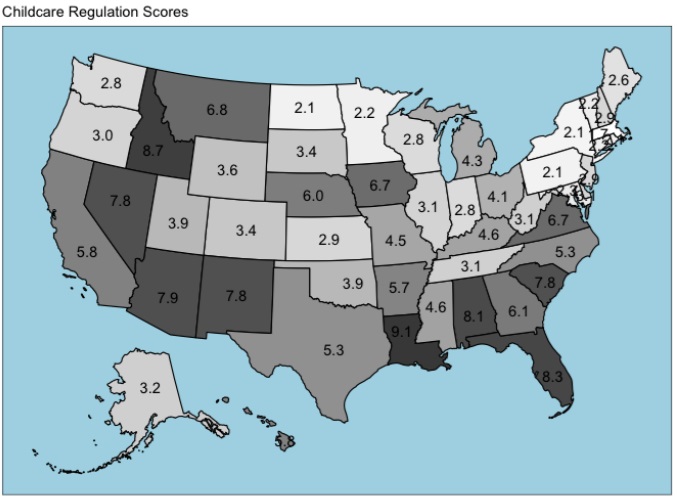I’ve repeatedly explained that government red tape generally fails a cost-benefit test.
Today, we’re going to look at a practical example.
Four economists (Anna Claire Flowers, Vincent J. Geloso, Clara E. Piano, and Lyman R. Stone) have a working paper that looks at the impact of state childcare regulations on fertility rates.
Here’s their map showing which states have the most red tape (policies involving things such as staff ratios, training requirements, and education mandates). Lighter-colored states have more regulation and darker-colored states have more freedom.

So what’s the impact of regulation?
For those who know the track record of red tape, you won’t be surprised to learn that states with more red tape have higher costs. And that leads to fewer children.
…many developed countries are considering childcare subsidies as a way to curb declining birth rates. …Given that 71.7 percent of mothers with children are employed in the labor force (compared to more than 92 percent for fathers), it is unsurprising that the relationship between fertility and the market for childcare remains an important question. In this paper, we ask whether one form of government intervention in the childcare market – the regulation of childcare – is associated with larger fertility gaps, here referring to the stylized fact that in high-income countries women tend to have fewer children than they report they would have liked to have. … Our approach varies from the family policies typical of the literature…in that childcare regulations are not usually explicitly presented as pro-, or anti-natal policies at all… Yet, we show that these regulations have large and possibly unintended effects on women’s likelihood of satiating preferences for childbearing. We measure childcare regulation intensity across the U.S. states… Both sets of results confirm that more relaxed regulatory environments are associated with narrower fertility gaps…more women achieve their fertility goals in states with less childcare regulation.
I can’t resist broadening the discussion.
I’ve written many times that there’s a desperate need for entitlement reform, in part because of falling birthrates (to be more specific, there will be too many older beneficiaries in the future and not enough younger workers to pay for them).
Maybe my friends on the left should support deregulation of child care so that there are more future taxpayers? After all, Ponzi schemes can be propped up if there is an ever-growing number of new entrants.


